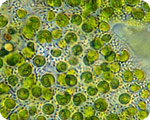
Protecting yourself in the event of a serious radiation event involves much more than simply loading up on potassium iodide and various other iodine supplements. While high levels of iodine do protect the thyroid and glandular systems from radiation poisoning, they do not necessarily protect the rest of your body from the devastating and deadly effects of nuclear radiation. However, two amazing superfoods — Spirulina and Chlorella — offer substantiated protection against harmful radiation. They also help to detoxify the body of harmful radiation after exposure, effectively protecting organs and other areas not protected by iodine.
Spirulina, the incredible medical food used to treat child victims of Chernobyl
The numerous curative and health-promoting properties of Spirulina are truly amazing. This blue-green algae superfood is rich in vitamins, minerals, trace minerals, and antioxidants, all of which make it highly beneficial as an anti-aging, anti-cancer, and super-detoxifying miracle food (http://www.naturalnews.com/spirulin…).
But little known is the incredible radioprotective power of Spirulina. Numerous studies have found that Spirulina protects the body against — and even heals it from — the damaging effects of harmful radiation.
A 1989 study put forth by researchers from Zhongkai Agriculture and Technology College in China found in tests that Spirulina significantly reduces the gamma radiation-induced micronucleus frequencies in the bone marrow of affected mice. Bone marrow, of course, is responsible for producing new blood cells and maintaining the lymphatic system (http://www.ncbi.nlm.nih.gov/pubmed/…).
A 1993 report published by the Research Institute of Radiation Medicine in Belarus confirmed previous research conducted in 1990-91 which found that Spirulina effectively decreases the radioactive load received by the body when consuming radiation-contaminated food. After just 20 days, children fed five-gram doses of Spirulina every day experienced an average 50 percent reduction in urine radioactivity levels (http://www.iimsam.org/publications_…).
In a study released by Mechnikov Odessa State University in Ukraine in 2000, Spirulina proved effective at increasing phosphate, pyruvate, and antioxidant levels in rats with lesions caused by 5 gray units (Gy) of high-energy radiation. Full-body exposure to 5 Gy or more typically leads to death within 14 days, but Spirulina helped to prevent this (http://www.ncbi.nlm.nih.gov/pubmed/…).
A 2001 study conducted by researchers from the Medical and Pharmaceutical Academe of Yangzhou University in China found that Spirulina extracts effectively protect against both the damage caused by chemotherapy drugs and the damaging effects of gamma radiation exposure (http://www.ncbi.nlm.nih.gov/pubmed/…).
Those negatively affected by high levels of radiation after working on cleanup efforts following the 1986 Chernobyl disaster experienced improvements in the autoregulatory functionality of their bodily organs and other systems, as well as long-term remission from overall radiation damage, after being treated with a regimen that included Spirulina (http://www.ncbi.nlm.nih.gov/pubmed/…).
Spirulina works so well at mitigating the damage caused by radiation that it was actually awarded a Russian patent in 1995 for improving the immunity of children affected by radiation from the Chernobyl disaster. Many exposed children became stricken with chronic radiation sickness and elevated Immunoglobulin E (IgE) levels, and they also tested positive for high allergy sensitivity. But upon consuming roughly five milligrams (mg) of Spirulina a day for 45 days, the children’s IgE levels and allergic sensitivities were restored back to normal.
Conclusively, Spirulina offers remarkable radioprotective benefits in addition to its many other health-promoting benefits. Regular consumption of Spirulina not only helps to boost immune function and normalize the systems in the body that regulate and maintain overall health, but the superfood also offers a surefire way to mitigate the damaging effects of harmful radiation (http://jpronline.info/article/viewF…).
Chlorella, the detoxifying superfood with amazing radioprotective benefits
Much like Spirulina, Chlorella is loaded with an astounding array vitamins, minerals, and nutrients that help detoxify the body of heavy metals and other contaminants. The single-cell algae also helps to prevent and repair DNA damage, balance the body’s pH levels, fight inflammation, improve digestive health, and boost immune function (http://www.naturalnews.com/027894_c…).
And as far as harmful radiation is concerned, Chlorella is a powerful weapon to both prevent radioactive damage and heal it once it has occurred.
A 1989 study put forth by the Czechoslovak Academy of Sciences demonstrated that Chlorella effectively increases production of bone marrow and spleen stem cells. And in tests, Chlorella greatly helped improve survival rates among mice irradiated with a lethal dose of radioactive gamma rays (http://www.ncbi.nlm.nih.gov/pubmed/…).
In 1993, researchers from Jawaharlal Nehru University in India also found that Chlorella is effective at protecting against and mitigating the damage caused by both acute and chronic radioactive damage (http://www.ncbi.nlm.nih.gov/pubmed/…).
A 1995 study published in the Indian Journal of Experimental Biology found that when administered before or upon exposure to sub-lethal radioactive gamma rays, Chlorella helps to boost levels of colony-forming spleen cells. Such cells exist within the bone marrow and are essential for the production of vital blood elements and immune factors (http://www.ncbi.nlm.nih.gov/pubmed/…).
Ultimately, the incredible detoxifying power of Chlorella is not limited to toxins like mercury, aluminum, and fluoride. Just like it does to toxic heavy metals, Chlorella binds to radioactive particles and literally flushes them out of the body. In complete synergy with its many other health-promoting functions, Chlorella is a vital superfood nutrient that numerous scientific studies have proven helps to guard the body against radioactive damage (http://www.naturalnews.com/027361_c…).
Both Spirulina and Chlorella are absolutely essential weapons in any natural radioprotective arsenal. Together, these powerful sea-based nutrients help to rid the body of radiation and the many other toxins that cause both acute and chronic damage to the body.


